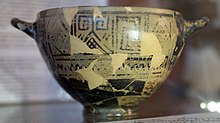Pithecusae Archaeological Museum
The Archaeological Museum of Pithecusae ( Italian Museo archeologico di Pithecusae ) is a museum in the municipality of Lacco Ameno on the island of Ischia . It is primarily dedicated to excavation finds of the ancient settlement Pithekoussai , which was founded by Greek colonizers around 770 BC. Was founded. The headquarters of the museum is located in the main building of the Villa Arbusto area, which is used as a cultural center for various purposes.
history
In 1947, the German-Italian archaeologist Giorgio Buchner (1914–2005) and the Swiss volcanologist Alfred Rittmann (1889–1970) founded a museum, which was merged with the findings discovered during later excavations to form a new museum. Today's Pithecusae Archaeological Museum was inaugurated on April 17, 1999 in the presence of prominent scholars such as the British archaeologist Sir John Boardman and the chief curator of the Louvre Museum Alain Pasquier .
Exhibition building
The Villa Arbusto was built in 1785 by Don Carlo Acquaviva , Duke of Atri , on the site of the l'Arbusto ("shrub") estate . After the Acquaviva men's line died out in 1805 and after the property had gone through many hands, it was acquired by the Italian film producer, publisher and entrepreneur Angelo Rizzoli (1889-1970) in 1952 . After the death of Rizzoli, the villa came into the possession of the municipality of Lacco Ameno and became the headquarters of the museum. The museum shows the history of the island from prehistory to Roman times in eight rooms and is located on the first floor of the building.
collection
Around 10,000 finds are inventoried in the museum. The most important come from the Greek settlement Pithekoussai, which was excavated from 1952 by Giorgio Buchner and his team.
Many finds come from the necropolis in the valley of San Montano, which today belongs to the local area of Lacco Ameno. The most famous find is the so-called Nestor Cup from Ischia . A three-line inscription in a Greek alphabet is carved on it. It is one of the earliest datable Greek inscriptions in alphabetical form. Its age can be traced back to the period between 725 and 720 BC. Classify.
Other vessels come from the nearby acropolis of Monte di Vico, especially black tableware (the so-called Campana A ) from the Hellenistic period , which was traded in many areas around the Mediterranean. The museum's holdings are rich in ancient amphorae . As the excavations showed, amphorae in Pithekoussai were not only used as storage and transport vessels for oil, olives, wine, etc., but they were also used as funerary urns for children.
Evidence from Roman times has not been found so numerous on Ischia. There are some votive reliefs from the 1st century. v. Exhibited in the museum until the 3rd century AD. They come from a sanctuary of the nymphs of Nitrodi, which was located near a spring near the village of Barano d'Ischia and was discovered by farmers in 1759. Some pieces of these finds are also shown in the National Archaeological Museum of Naples .
Kathryn Lomas from Durham University , a connoisseur of Italian history, rates the museum in her book The Rise of Rome as follows: “The Museo Archeologico di Pithecusae in Lacco Ameno on Ischia houses a fascinating collection of artifacts from the earliest Greek settlement in Italy, too if no building remains have been preserved. "
Uncertain future
The existence of the museum is in question. Many public institutions in Italy, including those in tourist strongholds, suffer from a lack of money. In 2015 the municipality of Lacco Ameno was facing financial failure. Mayor Giacomo Pascale announced that he was now forced to sell communal properties to fill the city coffers. This also includes the fillet of urban real estate, the Villa Arbusto. In the event of a sale, the museum would no longer be able to accommodate.
Currently (as of 2019) the museum is open to the public.
literature
- Four-language leaflet Museo archeologico di Pithecusae , Ministero per i Bene e le Attività Culturali Soprintendenza Archeologia, Belle Arti e Paesaggio della Cittá Metropolitana di Napoli, no year
- Pia de Simony, Stefanie Sonnentag, Bettina Dürr: Ischia . 11th edition, completely revised and redesigned. MairDumont GmbH & Co. KG, Ostfildern 2013, ISBN 978-3-8297-2479-1 , p. 56 (128 pp.).
Individual evidence
- ^ Giorgio Buchner, David Ridgway: Pithekoussai 1: La necropoli. tombe 1-723 scavate dal 1952 al 1961 . Roma 1993, ISBN 88-7689-074-2 (CCXV, 259 pp.).
- ↑ Klaus Rüter, Kjeld Matthiessen: To the Nestor cup from Pithekussai . In: Journal of Papyrology and Epigraphy . Vol. 2. Bonn 1968, pp. 231-255., P. 235.
- ↑ Kathryn Lomas: The Rise of Rome: From Romulus to Pyrrhus . Klett-Cotta, Stuttgart 2019, ISBN 3-608-96433-9 , pp. 42 (541 p., Limited preview in Google Book Search [accessed August 21, 2018]).
- ↑ Empty city coffers: Sale on Ischia. Deutschlandfunk, August 14, 2015, accessed on August 23, 2019 .



